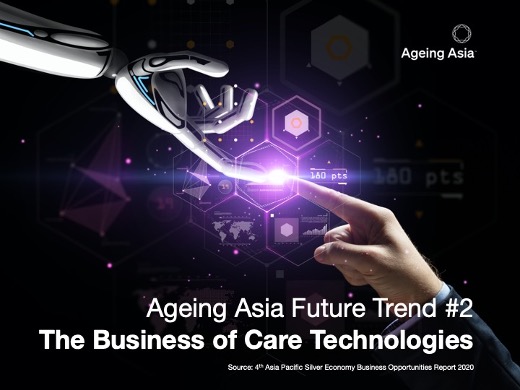The upside of ageing populations is the social and economic opportunities that emerge. We are already starting to reimagine live in a post COVID-19 world, and this includes an opportunity to transform how we care for older people, professionalise the care sector and identify new products and programmes that enable ageing-in-place and health longevity.
Today, the world of ageing is no longer one depicted by just images of frailty, grey hair and weaknesses, instead, the 60+ population in overthrowing all preconceive notions of what old looks and feels like, what older people want or even what the definition of old is.
In Singapore, the Ministry of Health (MOH) has a Build-Own-Lease (BOL) approach to prepare for the rising demand in nursing homes and integrated care facilities: the MOH bears the capital costs of building facilities, which are tendered out to Social Service Agencies (formerly known as Voluntary Welfare Organisations) and private operators.They are continuously looking to build healthcare capacity in acute and community hospitals, polyclinics, integrated facilities including nursing homes and senior centres to meet the increasing demand for healthcare services driven by the ageing population.
At the same time, private sector lead assisted living facilities have also emerged since 2015. In December 2020, Singapore’s “first assisted living public housing development” was announced – The Bukit Batok Community Care Apartments designed for older people.
Singapore currently has 4 hospital projects in the pipeline, as well as 15 primary care facilities (polyclinics) and 11 nursing homes under development. The government early this year said that it will set aside S$180m to develop over 200 eldercare centres by 2024.
For those looking to hear more about the future of ageing in Singapore, the World Ageing Festival 2021 will be profiling CEOs from the upcoming BOL projects and leaders of Singapore’s long term care sector in a panel discussion chaired by Mr Tan Kwang Cheak, CEO, Agency for Integrated Care (AIC), Singapore. Read More
Older people want independence
The new independent older person is ageing in better health that previous generations. Assisted living provides the assurance of housing with supportive services that enable activities of daily living whilst maintaining privacy, independence and dignity.
The number of people over the age of 80 will triple to 425 million globally in 2050. The changing needs and expectations of the Ageing population will drive changes in the way we deliver social, health, care, lifestyle and technologies.
Central to the success of delivering affordable housing and care services is understanding the concept of ageing-in-place. Older people need to live in their own homes for as long as possible, with dying at home as a norm rather than exception.
Care technology trends that enable ageing-in-place
One of the key trends to support ageing-in-place is the The Business of Care Technologies – the demand for assistive, operational and companion robotic technologies. The biggest market for care technologies is to help improve efficiency and productivity for staff, to enable them to allocate more time towards providing care and social engagement with seniors, as well as applying the data relevantly to support care delivery
A key challenge for the sector is to overcome the misconception that technology will replace human connections when we care for seniors. Prior to the pandemic, companies like ASCOM founded in Switzerland, were already frontrunners in delivering straight forward and non-obtrusive technology solutions for seniors.
One of the positive outcomes in the global fight against the COVID-19 pandemic is the rapid acceleration of the technology adoption curve for the aged care sector, and the use to technologies to enable independence for seniors
The Business of Care Technologies includes five broad areas:

• Demand for cloud communication, telehealth, remote business and remote clinical functions;
• Demand for assistive technologies to support care workers with client monitoring for falls prevention, health monitoring of medical conditions, robotic aid assistants to perform repetitive or delivery tasks around the facilities;
• Demand for smart home intelligence technologies that enable seniors to live at home with independence, including home appliances, assistive living products, and health monitoring technologies; and Support for daily living activities including robotic baths and smart hoists;
• Demand for companion robots with artificial intelligence to help support seniors with Dementia and social engagement; and
• Demand for technology innovations such as virtual reality that help facilitate remote staff training and training stimulations.
For more information on the report: https://ageingasia.com/trend/


